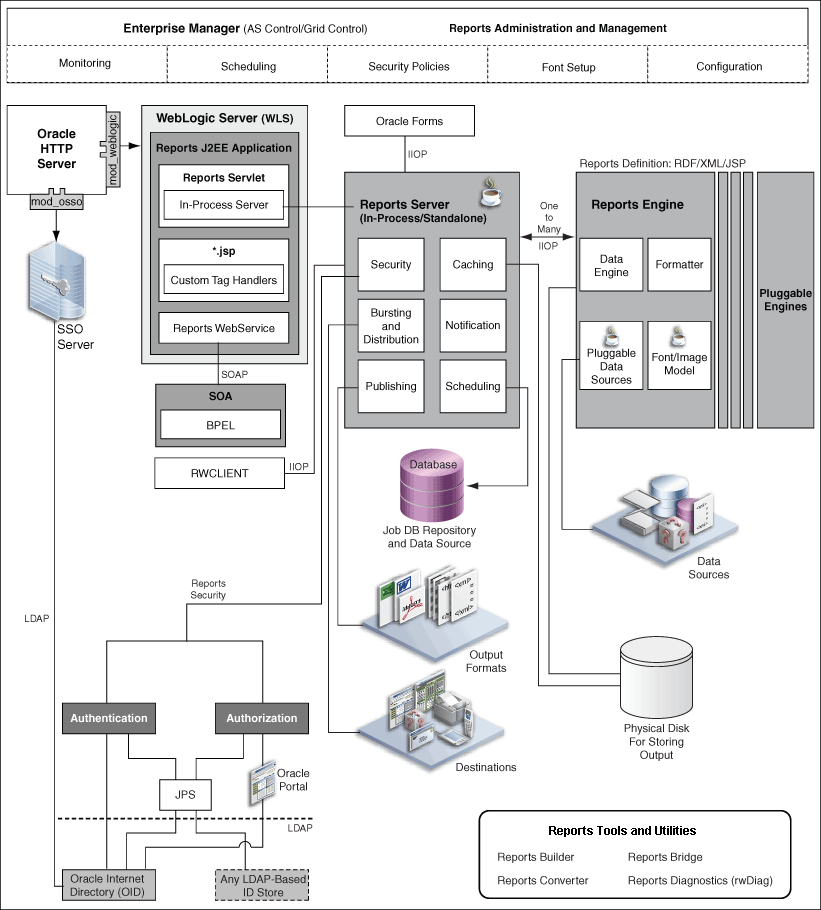Oracle Reports Services Components
Figure 2-1 Oracle Reports Services Components

Description of "Figure 2-1 Oracle Reports Services Components"
Figure 2-1 illustrates the components of a working Oracle Reports Services environment. This includes:
- The Oracle HTTP Server, a Web server provided by Oracle Fusion Middleware. It incorporates an OpenSSL module to provide support for Secure Sockets Layer (SSL) and HTTP Secure Sockets Layer (HTTPS). It also provides a servlet engine to support the running of Java servlet applications.
- The module mod_weblogic, used by the Oracle HTTP Server to redirect requests from servlets and JSPs to Oracle WebLogic Server. WebLogic Server provides a complete Java EE environment that includes a JSP translator, a JSP servlet engine (OJSP), and an Enterprise JavaBeans (EJB) container. It provides a fast, lightweight, highly scalable, easy-to-use, complete Java EE environment. It is written entirely in Java and executes on the standard Java Development Kit (JDK) Virtual Machine (JVM).
- The module mod_osso, used by the Oracle HTTP Server to connect to Single Sign-On Server. The Single Sign-On Server, in turn, uses Oracle Internet Directory.
- Oracle Reports Servlet (rwservlet), a component of Oracle Reports Services that runs inside the Web server's servlet engine. Oracle Reports Servlet (rwservlet) translates and delivers information between HTTP and Reports Server. It uses Single Sign-On Server for authentication. Oracle Reports Servlet includes:
- The in-process Reports Server, which reduces the maintenance and administration of the Reports Server by providing a means for starting the server automatically, whenever it receives the first request from the client through rwservlet or a Reports JSP.
- The Custom Tag Handler, which processes custom Oracle Reports tags included in a JSP file. In a JSP file, Oracle Reports-related custom tags are identified by the prefix rw:; other custom tags using other prefixes may also be present.
- The Reports Server (rwserver), which processes client requests, including ushering them through its various services, such as security (authentication and authorization, job scheduling, caching, publishing, and bursting and distribution (including distribution to custom—or pluggable—output destinations).
The security service offers authentication based on the following methods:
- Oracle Internet Directory
- Java Platform Security (JPS) Oracle Internet Directory
- Any LDAP-based ID Store using Java Platform Security (JPS)
- Java Platform Security (JPS) Oracle Internet Directory
- XML file-based
- Portal-based
The Reports Server also spawns runtime engines for generating requested reports, fetches completed reports from the Reports Server cache, and notifies the client that the job is ready. Reports output can be stored in the Reports cache or on a physical disk. - The Reports Server Cache, which securely stores completed job outputs.
- The Reports Engine, which includes components for running SQL-based and pluggable data source-based reports. It fetches requested data from the data source, formats the report, sends the output to cache, and notifies the Reports Server that the job is complete. The Reports engine also includes pluggable data sources, which are custom data sources like text, database, JDBC, OLAP, XML, and web services.
- The pluggable data sources, a set of design-time and runtime Java APIs that provide openness to Reports by enabling data input from numerous sources through the implementation of the PDS Java Interface. The PDS feature enables developers to leverage Reports' aggregation, summarization, formatting, and scheduling capabilities not only on data that is accessed through SQL, but also on data that is available elsewhere.
- The pluggable engines, which are custom engines that use Java APIs to pass jobs to the Reports Server, as well as leverage the server's other features, such as scheduling, distribution, notification, and caching. Oracle Reports Services provides an out-of-the-box pluggable engine called the URL engine. The URL engine enables you to distribute content from any publicly available URL to destinations such as e-mail, Oracle Portal, and WebDAV.
In addition to the Reports Services components, Figure 2-1 depicts the following:
- Integration of Oracle Reports with Service Oriented Architecture (SOA) through the web services module of the Reports J2EE application.
- Communication between Oracle Forms and Oracle Reports.
- Reports-specific modules in Enterprise Manager that enable you to administer and manage tasks, such as monitoring, scheduling, security policies, font setup, and configuration.
Additionally, the Oracle Reports Bridge provides functionality for discovering a Reports Server across Farms. The Oracle Reports Bridge acts as a gateway for packets that are broadcast by Reports Server/Reports Client across Farms. The Oracle Reports Bridge mechanism is not shown in Figure 2-1; for more information, see Section 2.3.4.1.2, "Server Discovery Across Subnets".
No comments:
Post a Comment